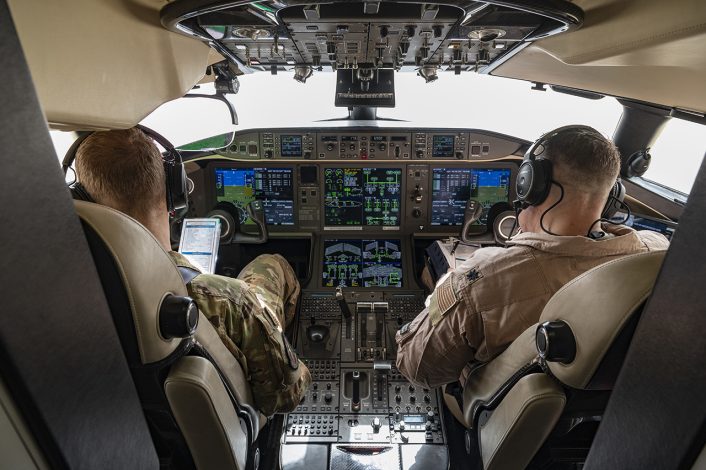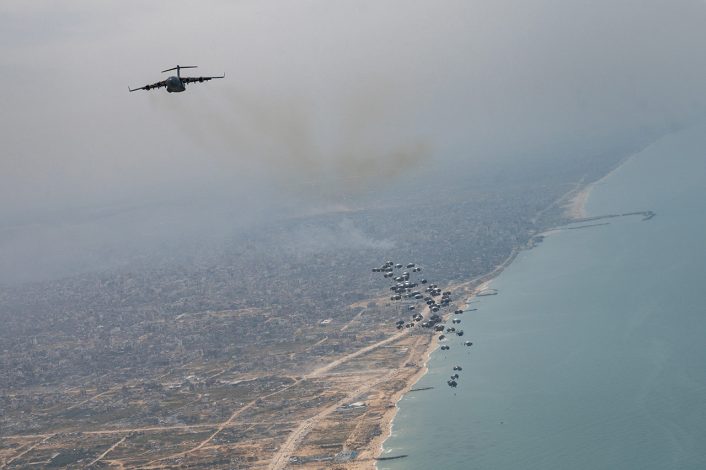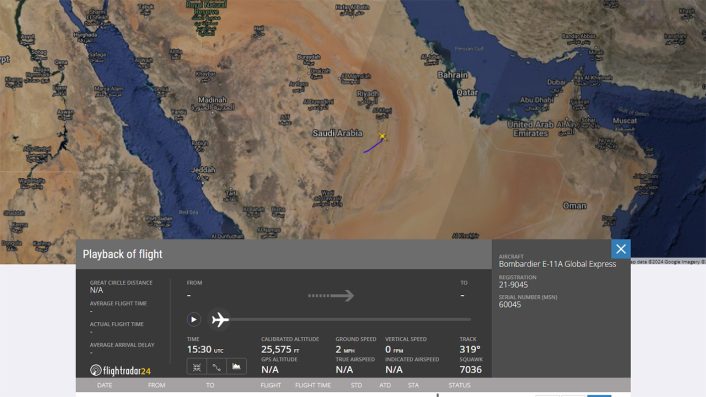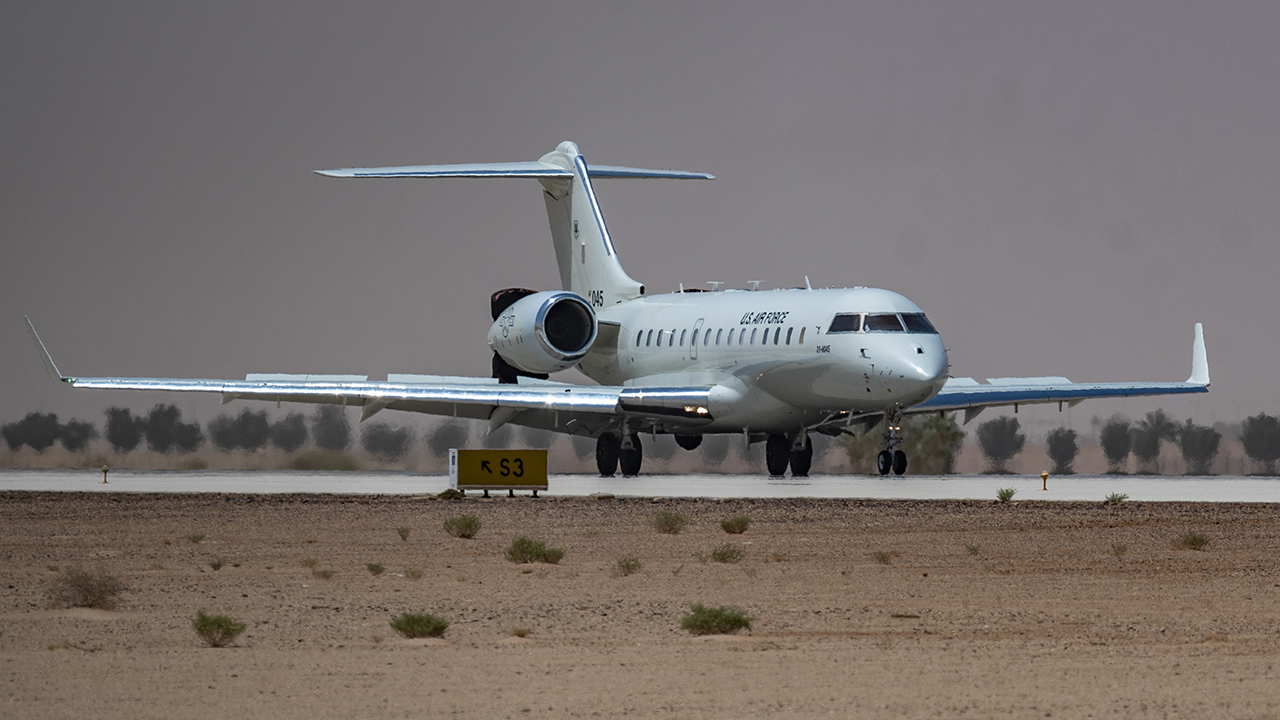The U.S. Air Force has been using its high-tech E-11A Battle Airborne Communications Node (BACN) to coordinate humanitarian airdrops over Gaza since March 2024.
Alongside recently released photos, the U.S. Air Force has revealed that its humanitarian aid drops over Gaza were supported from the air by Bombardier E-11A BACN aircraft operated by the 430th Expeditionary Electronic Combat Squadron from an undisclosed location.

The U.S Air Force conducted its first airdrop over Gaza on Mar. 2, 2024 following previous missions by Jordan, Egypt and France. Since then the United States has flown at least forty missions comprising over one hundred aircraft. Other nations, including the United Kingdom, Germany, and Spain have also since contributed aircraft.
Some concerns over this method of providing aid were raised following an incident which reportedly saw the tragic deaths of five people who were crushed when the parachute of a dropped pallet failed to deploy. However, with land and sea routes into Gaza bottlenecked, the airdrops continued.
The USAF airdrop sorties have been conducted by both Lockheed C-130 Hercules and Boeing C-17 Globemaster III transport aircraft.

The involvement of the E-11A in these missions hints at the complex nature of coordinating large-scale airdrops in an increasingly tangled operating environment. Between May 9 and June 9, the U.S. Air Force halted all airdrops citing intense Israeli Defence Force (IDF) operations in Rafah, southern Gaza, which would conflict with their operations and potentially expose civilians to harm. Weather conditions have also hampered aid delivery by air and by sea, with the U.S. led temporary pier that was designed to reduce reliance on airdrops suffering multiple weather and sea-state related setbacks.
Carrying the Battlefield Airborne Communications Node (BACN) system, commonly pronounced as ‘bacon’, the E-11A can support allied forces with a comprehensive communications relay capability from altitudes up to 51,000ft, supporting voice and data links across a wide area. The system was developed using NASA’s WB-57 high altitude research aircraft, which saw deployments to Afghanistan to test and deploy BACN in an operational environment.
The mountainous terrain of many parts of Afghanistan was a major factor in BACN’s development, as placing the communications node at a high altitude could overcome many of the issues faced by ground forces where line-of-sight based communications systems were not effective. Instead of relying on lines of sight between two operators in the field, they could instead use BACN as a bridging node to enable clear, unbroken communication as long as there was a clear view of the sky. This has led to some comparisons, even within the U.S. Air Force, between BACN equipped aircraft like the E-11A and low-earth orbit satellites.
With an E-11A overseeing the operational area for the airdrops, all forces, both American and allied, involved in the mission would have benefitted from a greater ability to have information shared immediately between them, helping to ensure the missions could be flown as safely and punctually as possible. In busy airspace with no ability to have forces on the ground directing the drops, nor any coordination from air traffic controllers, this would have been a vital connecting link.
Notably, for these missions the E-11A appears to have operated without Mode S or ADS-B enabled. Historically, operations by E-11A aircraft over Afghanistan were able to be monitored online using websites such as Flightradar24. Some E-11A operations over Iraq and Syria have continued to show, but for May 9, 2024 the available data for airframe 21-9045 (as pictured in official photographs) shows only a segment of flight over Saudi Arabia south of Riyadh.

It should be stressed that while flying without Mode S or ADS-B will usually prevent an aircraft from displaying on flight tracking websites, it does not automatically mean that the transponder is completely disabled or that the aircraft is not visible to air traffic controllers. Aircraft transponders operate in a variety of modes and most of these are not displayed by these websites as they do not include sufficient identifying information, and are more difficult to physically locate without the use of primary radar.
However, while we do not have complete data from the E-11A’s flights, we can deduce from the flight path available that the undisclosed location the aircraft operated from was Prince Sultan Air Base in Saudi Arabia, which is located southeast of Riyadh. This is no real surprise as the base has already been publicised as a forward operating location for the E-11A fleet.
The BACN capability is noted to be in high demand across the U.S. Central Command (CENTCOM) area of responsibility, and at least 20 crew members are kept on 24/7 alert ready for any operational need for the system that may arise. Because of the Global Express platform’s notable long endurance, with the Global 6000 variant that the E-11A is based on boasting a range in excess of 11,000km, E-11As are able to stay airborne for long durations and provide operational support to multiple taskings during a single sortie. To achieve the same operational flexibility, many other assets employed by the U.S. Air Force would require additional support in the form of refueling aircraft. Refueling in mid-air is not possible with the E-11A, but the aircraft’s range negates much of the need to begin with.
The E-11A fleet is due to grow to nine aircraft by 2027, up from the seven currently thought to be in service. One aircraft was lost in Afghanistan with two fatalities in 2020, with a mechanical failure and subsequent pilot error found to be the cause. A further E-11A is due to be divested in the coming year. This will likely be aircraft 11-9001, which is the oldest example in service and is unique in the fleet with large, distinctive radomes on the fuselage. Often confused for part of the BACN system, these radomes are actually redundant holdovers from the airframe’s prior role in the development of the Royal Air Force’s now retired Sentinel R1 platform. 11-9001 returned to the United States via RAF Mildenhall following a deployment to Prince Sultan Air Base in January.
BACN coming back stateside already?
🇺🇸 BLKWF16 is E-11A 11-9001 #AE4D27 pic.twitter.com/iqpclqVPbV
— Evergreen Intel (@vcdgf555) January 4, 2024
New E-11As being delivered are being stationed at Robins Air Force Base, Georgia, with the 18th Airborne Command and Control Squadron. This stateside unit, which will significantly increase training capacity and ability to take part in exercises, is a demonstration of the U.S. Air Force’s commitment to the E-11A platform and to the BACN system for the foreseeable future. Previous arrangements saw all E-11As forward deployed in theater, initially to Kandahar in Afghanistan and then to Prince Sultan Air Base following the withdrawal from Afghanistan.
As part of contracts negotiated to support the new CONUS E-11A unit, Northrop Grumman were also tasked with completing a modernisation programme for the aircraft, including the fitting of a new upgraded Ka-band SATCOM capability.
Meanwhile, the unmanned EQ-4B Global Hawks, which were modified to carry the same BACN system as the E-11A fleet, were retired in 2021 and handed to the Department of Defense Test Resource Management Center where they are being evaluated for use supporting weapons development tests. They had previously seen service during Operation Inherent Resolve.













